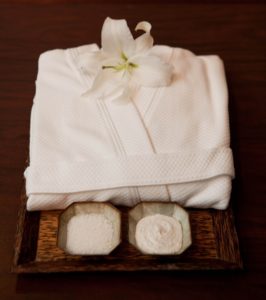I recently had a client on my table who had a very difficult time releasing. He was “like stone” (as we therapists love to say) and no matter how much force I applied, very little change was occurring to his musculature. I quickly realized the problem: this client was NOT BREATHING. One of my favorite guilty pleasure musicians, Alanis Morisette, was interviewed about a tattoo on her wrist which reads, simply: BREATHE. She said self-deprecatingly, “What kind of person needs to be reminded to breathe?” Well, apparently a vast majority of us do, Alanis. You are not alone.
I work with clients to realize the importance of deep, conscious breathing while they are receiving massage. This simple act can transform a deeply contracted area into one that has healthy circulation and a higher functionality and connectedness to the rest of the body. This simple technique of conscious breathing is especially important when receiving deeper work.
While on the table, gently concentrate on slowing down your breath. To start simply: take a nice slow inhalation, hold the breath comfortably for a second and then exhale slowly. With time, as those of you who practice yoga already know, your inhalation will slow down. This allows your body to metabolize a greater percentage of the oxygen you are taking in. Then you can begin to hold the space between inhalation and exhalation. This is partly mental discipline but also, I believe, helps to increase your own awareness of your body. Finally, a slow exhalation allows your body to expel more noxious gases from the body. This entire process done slowly and with awareness can do wonders to: lower levels of stress chemicals like cortisol, (as I’ve said) heighten awareness of your body, stimulate the parasympathetic nervous system (responsible for the relaxation response/ “rest and digest”), and can act to distract you as a client from any discomfort that deeper more directed pressures from a massage therapist may cause.
More esoterically, yogis and meditative masters have long understood the power of the breath to move prana/chi/life force in, around and through the body. They know that the breath moves many of your bodily, mental and (if you will) spiritual functions to a greater place of balance and efficiency. I have seen this simple practice of coming back to the breath, coming back to the moment transform my experience of myself, help clients with severe and chronic pain and turn a massage treatment into a total experience outside of the fast and sometimes vapid daily routine.
I will leave you with one last practice that you can add to your simple breathing exercises. This comes from the Vietnamese Zen Master and all around cool dude, Thich Nhat Hanh. While you are breathing consciously, you can practice these thoughts to yourself, or come up with whatever will help you achieve calm awareness best: Breathing in, I know I am breathing in. Breathing out, I know I am breathing out. “Breathing in, I feel calm. Breathing out, I feel at ease.” I am not struggling anymore. Calm/ease.” And then, “Breathing in, I smile. Breathing out, I release all my worries and anxieties. Smile/release.”




